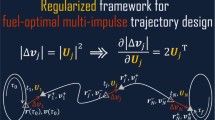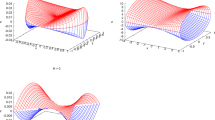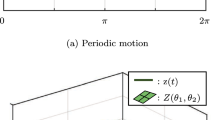Abstract
The problem of regularization of the classical equations of celestial mechanics and space flight mechanics (astrodynamics) is considered, in which variables are used that characterize the shape and dimensions of the instantaneous orbit (trajectory) of the moving body under study, and Euler angles describing the orientation of the rotating (intermediate) coordinate system used, or the orientation of the instantaneous orbit, or orbital plane of the moving body in the inertial coordinate system. Singularity-type (divide-by-zero) singularities of these classical equations are generated by Euler angles and effectively eliminated by using four-dimensional Euler (Rodrigues–Hamilton) parameters and Hamiltonian rotation (rotation) quaternions.
The article presents a review and analysis of the models of celestial mechanics and astrodynamics, known to us, regular in the indicated sense, constructed using the Euler parameters and Hamilton rotation quaternions based on the differential equations of the perturbed three-body problem. The applications of these models in the problems of optimal control of the orbital motion of a spacecraft, which are solved using the Pontryagin maximum principle, are considered. It is shown that the efficiency of analytical research and numerical solution of boundary value problems of optimal control of the trajectory (orbital) motion of spacecraft can be dramatically increased through the use of regular quaternion models of astrodynamics.
There is also a review and analysis of publications that use dual Euler parameters and dual quaternions (Clifford biquaternions) to solve the problems of controlling the general spatial motion of a rigid body (spacecraft), which is a composition of rotational (angular) and translational (orbital) motions of a rigid body, equivalent to its screw motion, using the feedback principle.
Similar content being viewed by others
REFERENCES
Yu. N. Chelnokov, “Analysis of optimal motion control for a material point in a central field with application of quaternions,” J. Comp. Syst. Sci. Int. 46 (5), 688-713 (2007). https://doi.org/10.1134/S1064230707050036
Yu. N. Chelnokov, Quaternion Models and Methods in Dynamics, Navigation, and Motion Control (Fizmatlit, Moscow, 2011) [in Russian].
Yu. N. Chelnokov, “Quaternion regularization in celestial mechanics and astrodynamics and trajectory motion control. I,” Cosmic Res. 51 (5), 350–361 (2013). https://doi.org/10.1134/S001095251305002X
Yu. N. Chelnokov, “Quaternion regularization in celestial mechanics, astrodynamics, and trajectory motion control. III,” Cosmic Res. 53 (5), 394–409 (2015). https://doi.org/10.1134/S0010952515050044
Yu. N. Chelnokov, “Quaternion regularization of the equations of the perturbed spatial restricted three-body problem: I,” Mech. Solids 52 (6), 613–639 (2017). https://doi.org/10.3103/S0025654417060036
G. N. Duboshin, Celestial Mechanics: Methods of the Theory of Motion of Artificial Celestial Bodies (Nauka, Moscow, 1983) [in Russian].
V. K. Abalakin, E. P. Aksenov, E. A. Grebenikov, et al., Reference Manual in Celestial Mechanics and Astrodynamics (Nauka, Moscow, 1976) [in Russian].
W. R. Hamilton, Lectures on Quaternions (Hodges and Smith, Dublin, 1853).
P. Kustaanheimo, “Spinor regularization of the Kepler motion,” Ann. Univ. Turku 73, 3–7 (1964).
P. Kustaanheimo and E. Stiefel, “Perturbation theory of Kepler motion based on spinor regularization,” J. Reine Anqew. Math. 218, 204–219 (1965).
E. L. Stiefel and G. Scheifele, Linear and Regular Celestial Mechanics (Springer, Berlin, 1971).
A. Deprit, “Ideal frames for perturbed keplerian motions,” Celest. Mech. 13 (2), 253–263 (1976).
V. A. Brumberg, Analytical Algorithms of Celestial Mechanics (Nauka, Moscow, 1980) [in Russian].
A. F. Bragazin, V. N. Branets, and I. P. Shmyglevskii, “Description of orbital motion using quaternions and velocity parameters,” in Abstracts of Reports at the 6th All-Union Congress on Theoret. and Applied Mechanics (Fan, Tashkent, 1986), pp. 133 [in Russian].
V. N. Branets and I. P. Shmyglevskii, Introduction to the Theory of Strapdown Inertial Navigation Systems (Nauka, Moscow, 1992) [in Russian].
J. Pelaez, J. M. Hedo, and P. Rodriguez de Andres, “A special perturbation method in orbital dynamics,” Celest. Mech. Dyn. Astron. 97, 131–150 (2007). https://doi.org/10.1007/s10569-006-9056-3
G. Bau, H. Urrutxua, and J. Pelaez, “EDROMO: An accurate propagator for elliptical orbits in the perturbed two-body problem,” Adv. Astronaut. Sci. 152 (06), 379–399 (2014).
G. Bau, C. Bombardelli, J. Pelaez, and E. Lorenzini, “Non-singular orbital elements for special perturbations in the two-body problem,” MNRAS 454 (3), 2890–2908 (2015). https://doi.org/10.1093/mnras/stv2106
P. Libraro, PhD Dissertation (Princeton University, Princeton, New Jersey, 2016).
J. Roa and J. Kasdin, “Alternative set of nonsingular quaternionic orbital elements,” J. Gui. Contr. Dyn. 40 (11), 2737–2751 (2017). https://doi.org/10.2514/1.G002753
D. Amato, C. Bombardelli, G. Bau, et al., “Non-averaged regularized formulations as an alternative to semi-analytical orbit propagation methods,” Celest. Mech. Dyn. Astron. 131, 21 (2019). https://doi.org/10.1007/s10569-019-9897-1
G. Bau and J. Roa, “Uniform formulation for orbit computation: the intermediate elements,” Celest. Mech. Dyn. Astron. 132, 10 (2020). https://doi.org/10.1007/s10569-020-9952-y
H. Andoyer, Cours de Mecanigue Celeste (Gauthier-Villars, Paris, 1923).
A. Deprit, “Ideal elements for perturbed Keplerian motions,” J. Res. National Bureau Stand. - B. Mat. Sci. 79B (1-2), 1-15 (1975). https://doi.org/10.6028/JRES.079B.001
P. Musen, “Application of Hansen’s theory to the motion of an artificial satellite in the gravitational field of the Earth,” J. Geophys. Res. 64 (12), 2271–2279 (1959). https://doi.org/10.1029/JZ064i012p02271
E. W. Brown and C. A. Shook, Panetary Theory (Cambridge Univ. Press, Cambridge, 1933).
P. Musen, “On stromgren’s method of special perturbations,” J. Astron. Sciences. 8, 48–51 (1961).
P. Musen, On the Application of Pfaff’s Method in the Theory of Variation of Astronomical Constants, NASA Technical Note D-2301 (Goddard Space Flight Center, Greenbelt, MD, 1964).
R. Broucke, H. Lass, and M. Ananda, “Redundant variables in celestial mechanics,” Astron. Astrophys. 13, 390–398 (1971).
Yu. N. Chelnokov, “Regular equations of the three-dimensional two body problem,” Mech. Solids 19 (1), 1–7 (1984).
Yu. N. Chelnokov, “On regularization of the equations of the three-dimensional two body problem,” Mech. Solids 16 (6), 1–10 (1981).
W. Clifford, “Preliminary sketch of biquaternions,” Proc. London Math. Soc. 4, 381–395 (1873).
Yu. N. Chelnokov, “On integration of kinematic equations of a rigid body’s screw-motion,” J. Appl.Math. Mech. 44 (1), 19–23 (1980). https://doi.org/10.1016/0021-8928(80)90168-9
Yu. N. Chelnokov, Quaternion Methods in Problems of Perturbed Motion of a Material Point. Part 1. General Theory. Applications to Problem of Regularization and to Problem of Satellite Motion, Available from VINITI, No. 8628-B (Moscow, 1985).
Yu. N. Chelnokov, Quaternion Methods in Problems of Perturbed Motion of a Material Point. Part 2. Three-Dimensional Problem of Unperturbed Central Motion. Problem with Initial Conditions, Available from VINITI, No. 8629-B (Moscow, 1985).
Yu. N. Chelnokov, “Quaternion regularization and stabilization of perturbed central motion. I,” Mech. Solids 28 (1), 16–25 (1993).
Yu. N. Chelnokov, “Quaternion regularization and stabilization of perturbed central motion. II,” Mech. Solids 28 (2), 1-12 (1993).
Yu. N. Chelnokov, “Application of quaternions in the theory of orbital motion of an artificial satellite. I,” Cosmic Res. 30 (6), 612–621 (1992).
Yu. N. Chelnokov, “Application of quaternions in the theory of orbital motion of an artificial satellite. II,” Cosmic Res. 31 (3), 409–418 (1993).
Yu. N. Chelnokov, “Regular quaternion models of perturbed orbital motion of a rigid body in the Earth’s gravitational field,” Prikl. Mat. Mekh. 83 (4), 562–585 (2019). https://doi.org/10.1134/S003282351902005X
Yu. N. Chelnokov, “Regular quaternion models of perturbed orbital motion of a rigid body in the Earth’s gravitational field,” Mech. Solids 55 (7), 958–976 (2020). https://doi.org/10.3103/S0025654420070079
Yu. N. Chelnokov, “Construction of optimum control and trajectories of spacecraft flight by employing quaternion description of orbit spatial orientation,” Cosmic Res. 35 (5), 499–507 (1997).
Yu. N. Chelnokov, “Application of quaternions to space flight mechanics,” Giroskop. Navig., No. 4 (27), 47–66 (1999).
Yu. N. Chelnokov, “Optimal control of spacecraft motion in the newtonian gravitational field: application of quaterni-ons to describe orbit orientation,” Cosmic Res. 37 (4), 409–418 (1999).
Yu. N. Chelnokov, “The use of quaternions in the optimal control problems of motion of the center of mass of a spacecraft in a Newtonian gravitational field: I,” Cosmic Res. 39, 470–484 (2001). https://doi.org/10.1023/A:1012345213745
Yu. N. Chelnokov, “The use of quaternions in the optimal control problems of motion of the center of mass of a spacecraft in a Newtonian gravitational field: II,” Cosmic Res. 41, 85–99 (2003). https://doi.org/10.1023/A:1022359831200
Yu. N. Chelnokov, “Quaternion regularization and trajectory motion control in celestial mechanics and astrodynamics: II,” Cosmic Res. 52, 304–317 (2014). https://doi.org/10.1134/S0010952514030022
Yu. N. Chelnokov, Quaternion and Biquaternion Models and Methods of Mechanics of Solids and Their Applications (Fizmatlit, Moscow, 2006) [in Russian].
Yu. N. Chelnokov, “Optimal reorientation of a spacecraft’s orbit using a jet thrust orthogonal to the orbital plane,” J. Appl. Math. Mech. 76 (6), 646-657 (2012). https://doi.org/10.1016/j.jappmathmech.2013.02.002
R. H. Battin, An Introduction to the Mathematics and Methods of Astrodynamics (AIAA Press, New York, 1987). https://doi.org/10.2514/4.861543
Yu. V. Afanasyeva and Yu.N. Chelnokov, “The problem of rendezvous of a controlled space vehicle with an uncontrolled space vehicle moving along an elliptical keplerian orbit in the central newtonian gravitational field,” J. Comput. Syst. Sci. Int. 46 (3), 468-484 (2007). https://doi.org/10.1134/S106423070703015X
Yu. V. Afanasyeva and Yu.N. Chelnokov, “The problem of optimal control of the orientation of an orbit of a spacecraft as a deformable figure,” J. Comput. Syst. Sci. Int. 47, 621–634 (2008). https://doi.org/10.1134/S106423070804014X
I. A. Pankratov, Ya. G. Sapunkov, and Yu. N. Chelnokov, “About a problem of spacecraft’s orbit optimal reorientation,” Izv. Saratov Univ. (N.S.), Ser. Math. Mech. Inform. 12 (3), 87–95 (2012).
I. A. Pankratov, Ya. G. Sapunkov, and Yu. N. Chelnokov, “Solution of a problem of spacecraftтaщs orbit optimalreorientation using quaternion equations of orbital systemof coordinates orientation,” Izv. Saratov Univ. (N. S.) Ser. Math. Mekh. Inform. 13 (1), 84–92 (2013).
Ya. G. Sapunkov and Yu. N. Chelnokov, “Investigation of the task of the optimal reorientation of a spacecraft orbit through a limited or impulse jet thrust, orthogonal to the plane of the orbit. Part 1,” Mekh. Avt. Upr. 17 (8), 567–575 (2016). https://doi.org/10.17587/mau.17.567-575
Ya. G. Sapunkov and Yu. N. Chelnokov, “Investigation of the task of the optimal reorientation of a spacecraft orbit through a limited or impulse jet thrust, orthogonal to the plane of the orbit. Part 1,” Mekh. Avt. Upr. 17 (9), 633–643 (2016). https://doi.org/10.17587/mau.17.663-643
Y. G. Sapunkov and Y. N. Chelnokov, “Optimal rotation of the orbit plane of a variable mass spacecraft in the central gravitational field by means of orthogonal thrust,” Autom. Remote. Control 80, 1437–1454 (2019). https://doi.org/10.1134/S000511791908006X
Y. G. Sapunkov and Y. N. Chelnokov, “Pulsed optimal spacecraft orbit reorientation by means of reactive thrust orthogonal to the osculating orbit. I,” Mech. Solids 53, 535–551 (2018). https://doi.org/10.3103/S0025654418080083
Y. G. Sapunkov and Y. N. Chelnokov, “Pulsed optimal spacecraft orbit reorientation by means of reactive thrust orthogonal to the osculating orbit. II,” Mech. Solids 54, 1–18 (2019). https://doi.org/10.3103/S0025654419010011
Ya. G. Sapunkov and Yu. N. Chelnokov, “Quaternion solution of the problem of optimal rotation of the orbit plane of a variable-mass spacecraft using thrust orthogonal to the orbit plane,” Mech. Solids 54, 941–957 (2019). https://doi.org/10.3103/S0025654419060098
M. Kopnin, “On the task of rotating a satellite’s orbit plane,” Kosm. Issl. 3 (4), 22-30 (1965).
V. N. Lebedev, Computation of Motion of a Spacecraft with Small Traction (VTs AN SSSR, Moscow, 1967) [in Russian].
M. Z. Borshchevskii and M. V. Ioslovich, “On the problem of rotating the orbital plane of a satellite by means of reactive thrust,” Kosm. Issl. 7 (6), 8-15 (1969).
G. L. Grodzovskii, Yu. N. Ivanov, and V. V. Tokarev, Mechanics of Space Flight, Optimization Problems (Nauka, Moscow, 1975) [in Russian].
D. E. Okhotsimskii and Yu. G. Sikharulidze, Foundations of Space Flight Mechanics (Nauka, Moscow, 1990) [in Russian].
S. A. Ishkov and V. A. Romanenko, “Forming and correction of a high-elliptical orbit of an earth satellite with low-thrust engine,” Cosm. Res. 35 (3), 268–277 (1997).
V. N. Branets and I. P. Shmyglevskii, Application of Quaternions in Problems of Attitude Control of a Rigid Body (Nauka, Moscow, 1973) [in Russian].
Yu. N. Chelnokov, “A screw method for the description of the motion of a rigid body,” in Collection of Research and Methodology Papers on Theoretical Mechanics, Issue 11 (Vysshaya Shkola, Moscow, 1981), pp. 129–138 [in Russian].
Yu. N. Chelnokov, “One form of the inertial navigation equations,” Izv. Akad. Nauk SSSR. Mekh. Tverd. Tela, No. 5, 20–28 (1981).
A. P. Kotelnikov, Helical Calculus and Some of Its Applications to Geometry and Mechanics (Kazan, 1895) [in Russian].
A. P. Kotelnikov, “Screws and complex numbers,” Izv. Fiz.-Mat. Obshch. Imper. Kazan. Univ. Ser. 2, No. 6, 23–33 (1896).
N. A. Strelkova, “Optimal in the speed of response kinematic control of screw displacement of a rigid body,” Izv. Akad. Nauk SSSR. Mekh. Tverd. Tela, No. 4, 73–76 (1982).
V. V. Malanin and N. A. Strelkova, Optimal Control of Orientation and Helical Motion of a Rigid Body (NITs “Regularn. i Khaotich. Dinamika,” Moscow-Izhevsk, 2004) [in Russian].
D. Han, Q. Wei, and Z. Li, “Kinematic control of free rigid bodies using dual quaternions,” Int. J. Automat. Comput. 5 (3), 319–324 (2008). https://doi.org/10.1007/s11633-008-0319-1
D. Han, Q. Wei, Z. Li, and W. Sun, “Control of oriented mechanical systems: a method based on dual quaternion,” IFAC Proc. Vols. 41 (2), 3836–3841 (2008). https://doi.org/10.3182/20080706-5-KR-1001.00645
D. Han, Q. Wei, and Z. Li, “A dual-quaternion method for control of spatial rigid body. networking, sensing and control,” in 2008 IEEE Intern. Conf. Networking Sensing Control (IEEE, 2008), pp. 1–6. https://doi.org/10.1109/ICNSC.2008.4525172
E. Ozgur and Y. Mezouar, “Kinematic modeling and control of a robot arm using unit dual quaternions,” Robot. Autonom. Syst. 77, 66–73 (2016).
Yu. N. Chelnokov, “Biquaternion solution of the kinematic control problem for the motion of a rigid body and its application to the solution of inverse problems of robot-manipulator kinematics,” Mech. Solids 48, 31–46 (2013). https://doi.org/10.3103/S0025654413010044
Yu. N. Chelnokov and E. I. Nelaeva, “Biquaternion solution of the kinematic problem on optimal nonlinear stabilization of arbitrary program movement of free rigid body,” Izv. Sarat. Univ. Nov. Ser., Ser.: Mat., Mekh., Inf. 16 (2), 198–206 (2016).
A. Perez and J. M. McCarthy, “Dual quaternion synthesis of constrained robotic systems,” J. Mech. Design. 126 (3), 425–435 (2004). https://doi.org/10.1115/1.1737378
D. Han, Q. Wei, Z. Li, and W. Sun, “Control of oriented mechanical systems: a method based on dual quaternions,” IFAC Proc. Vols. 41 (2), 3836–3841 (2008). https://doi.org/10.3182/20080706-5-KR-1001.00645
M. Schilling, “Universally manipulable body models – dual quaternion representations in layered and dynamic MMCs,” Auton. Rob. 30, 399–425 (2011). https://doi.org/10.1007/s10514-011-9226-3
F. Zhang and G. Duan, “Robust integrated translation and rotation finite-time maneuver of a rigid spacecraft based on dual quaternion,” in AIAA Guid. Navig. Control Conf. 2011. Portland, Oregon. USA (AIAA, 2011), pp. 6396. https://doi.org/10.2514/6.2011-6396
J. Wang and Z. Sun, “6DOF Robust adaptive terminal sliding mode control for spacecraft formation flying,” Acta Astron. 73, 76–87 (2012). https://doi.org/10.1016/j.actaastro.2011.12.005
J. Wang, H. Liang, Z. Sun, et al., “Finite-time control for spacecraft formation with dualnumber based description,” J. Guid. Contr. Dyn. 35 (3), 950–962 (2012). https://doi.org/10.2514/1.54277
J. Wang and C. Yu, “Unit dual quaternion-based feedback linearization tracking problem for attitude and position dynamics,” Syst. Control Lett. 62 (3), 225–233 (2013). https://doi.org/10.1016/j.sysconle.2012.11.019
N. Filipe and P. Tsiotras, “Rigid body motion tracking without linear and angular velocity feedback using dual quaternions,” in 2013 European Control Conference (ECC) (IEEE, 2013), pp, 329–334. https://doi.org/10.23919/ECC.2013.6669564
U. Lee, PhD Dissertation (Univ. of Washington, 2014).
N. Filipe, M. Kontitsis, and P. Tsiotras, “Extended Kalman filter for spacecraft pose estimation using dual quaternions,” J. Guid. Contr. Dyn. 38 (9), 1625–1641 (2015). https://doi.org/10.2514/1.G000977
N. Filipe and P. Tsiotras, “Adaptive position and attitude–tracking controller for satellite proximity operations using dual quaternions,” J. Guid. Contr. Dyn. 38 (4), 566–577 (2015).
U. Lee and M. Mesbahi, “Optimal powered descent guidance with 6-DoF line of sight constraints via unit dual quaternions,” in AIAA Guidance, Navigation, and Control Conference. 5–9 January 2015 Kissimmee, Florida (AIAA, 2015), 0319. https://doi.org/10.2514/6.2015-0319
H. Gui and G. Vukovich, “Cite as dual-quaternion-based adaptive motion tracking of spacecraft with reduced control effort,” Nonlin. Dyn. 83 (1–2), 597–614 (2016).
S. A. Akhramovich, V. V. Malyshev, and A. V. Starkov, “Mathematical model of drone motion in the biquaternion form,” Polet 4, 9–20 (2018).
S. A. Akhramovich and V. V. Malyshev, “Biquaternions application in the aircraft control problems,” in System Analysis, Control and Navigation. Proceedings (MAI, Moscow, 2018), pp. 117–120 [in Russian].
S. A. Akhramovich and A. V. Barinov, “The system for controlling drone’s motion with predicting model in the biquaternion form,” in System Analysis, Control and Navigation. Proceedings (MAI, Moscow, 2018), pp. 120–122 [in Russian].
C. Garcia, D. M. Prett, and M. Morari, “Model predictive control: theory and practice,” Automatica, No. 3, 335–348 (1989).
Yu. N. Chelnokov, “Controlling the spatial motion of a rigid body using biquaternions and dual matrices,” Mech. Solids 56, 13–33 (2021). https://doi.org/10.3103/S0025654421010064
Yu. N. Chelnokov, “Synthesis of control of spatial motion of a rigid body using dual quaternions,” Prikl. Mat. Mekh. 83 (5–6), 704–733 (2019). https://doi.org/10.1134/S0032823519050035
Yu. N. Chelnokov, “Synthesis of control of spatial motion of a rigid body using dual quaternions,” Mech. Solids 55 (7), 977–998 (2020). https://doi.org/10.3103/S0025654420070080
Yu. N. Chelnokov, “Quaternion methods and models of regular celestial mechanics and astrodynamics,” Appl. Math. Mech.- Engl. Ed. 43 (1), 21–80 (2022). https://doi.org/10.1007/s10483-021-2797-9
Author information
Authors and Affiliations
Corresponding author
Additional information
Translated by I. K. Katuev
About this article
Cite this article
Chelnokov, Y.N. Quaternion Methods and Regular Models of Celestial Mechanics and Space Flight Mechanics: The Use of Euler (Rodrigues–hamilton) Parameters to Describe Orbital (Trajectory) Motion. I: Review and Analysis of Methods and Models and Their Applications. Mech. Solids 57, 961–983 (2022). https://doi.org/10.3103/S0025654422050041
Received:
Revised:
Accepted:
Published:
Issue Date:
DOI: https://doi.org/10.3103/S0025654422050041




